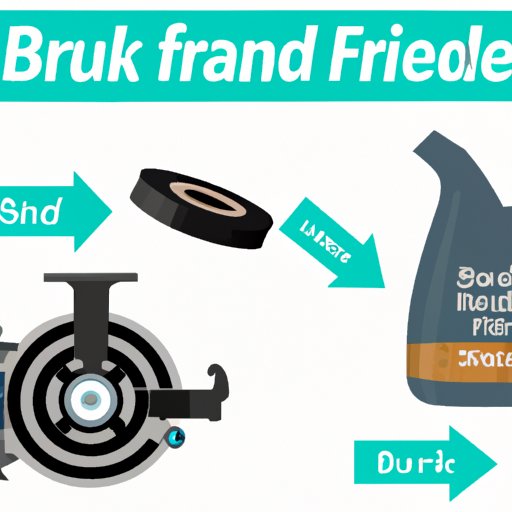
Introduction
Brake fluid is a vital component of a vehicle’s braking system, responsible for transmitting hydraulic pressure from the brake pedal to the brake calipers. Regularly changing your vehicle’s brake fluid is essential to ensure proper braking performance, reduce the risk of brake failure, and extend the lifespan of the braking system. In this article, we will guide you through the process of changing your vehicle’s brake fluid safely and effectively.
The Tools You’ll Need
Before starting, you would need the following tools:
- Brake fluid
- Jack stands
- Wrenches
- Tubing or vacuum pump
- Pan or bucket to collect old brake fluid
- Clean rags or towels
- Safety glasses and gloves
Each tool in the above list is essential in ensuring that the changing process is successful.
Understanding Brake Fluid
Brake fluid is a hydraulic fluid that transmits force from the brake pedal to the brake pads or shoes, causing the brakes to engage. Brake fluid is hygroscopic, which means it readily absorbs moisture from the air. Over time, this moisture accumulation can degrade the brake fluid, reducing its performance and the effectiveness of the brakes. Brake fluid should be changed every two years regardless of the mileage on the vehicle or as recommended by the vehicle manufacturer.
Step-by-Step Guide to Changing Brake Fluid
Here is a step-by-step guide on how to change brake fluid:
Locating the Brake Fluid Reservoir and Determining the Amount of Brake Fluid Needed
The brake fluid reservoir is usually located in the engine compartment near the brake booster and master cylinder. Remove the cap from the reservoir and look inside. There should be a minimum and maximum line that indicates how much fluid is required. Determine the type of brake fluid recommended for your vehicle in the owner’s manual or the cap of the reservoir.
Draining the Old Brake Fluid
Locate the brake bleed valve on the brake caliper. Attach the tubing or vacuum pump to the bleed valve. Place the other end of the tubing into a pan or bucket for disposing of the old brake fluid. Using the wrench, loosen the bleed valve and allow the old fluid to drain completely. Some vehicles may require the removal of all four wheels entirely.
Refilling the Brake Fluid Reservoir with New Fluid
Once all the old fluid is drained, fill the reservoir with fresh brake fluid as per the manufacturer’s specification. Add the fluid gently, taking care not to spill any on the paint or engine parts as brake fluid can damage them.
Bleeding the Brakes to Ensure Proper Brake Performance
Attach a hose to the valve on the brake caliper, then slowly pump the brake pedal several times until the fluid coming out of the caliper becomes clear with no air bubbles. If there is air in the system, the next step is to bleed the brakes. This process may differ from vehicle to vehicle, and it’s recommended to visit a professional mechanic or refer to the vehicle’s owner manual before proceeding.
Safety Tips
Safety is critical when changing brake fluid. When changing brake fluid, follow these safety tips:
- Ensure the car is on a level surface and properly supported with jack stands.
- Wear safety glasses and gloves to protect yourself from hazardous materials such as brake fluid and dust.
- Properly dispose of old brake fluid as it can be harmful if ingested. Avoid pouring the used brake fluid, down the drain, or releasing it into the environment.
Troubleshooting Tips
Some issues may arise when changing brake fluid. Here are solutions to common problems:
Air in the Brake Lines
If air is present in the brake lines, this can cause your brakes to feel spongy. The best way to bleed the air out of the brake system is to bleed the brakes again until all the air bubbles are gone, and the fluid coming out of the calipers is clear.
A Brake Pedal that Feels Spongy
If the brake pedal still feels spongy after bleeding the brakes, it could be an issue with the master cylinder. A faulty master cylinder won’t create enough pressure to actuate the brakes. In this case, it’s best to take your car to a professional for repair.
Leaks in the Brake System
If there are leaks in the brake system, this could lead to a loss of brake fluid pressure. Inspect the brake lines, brake calipers, and master cylinder for any sign of leakage. Replace any damaged components and always monitor the brake fluid level to ensure that there is no leakage.
FAQs
How often should you change brake fluid?
You should replace your brake fluid as recommended by your vehicle manufacturer, which is usually every two years. However, if you frequently drive in harsh conditions like stop-and-go traffic or mountainous terrain, you may need to replace it more frequently.
What type of brake fluid should you use?
Always use the brake fluid recommended by the vehicle manufacturer, which can be found in the owner’s manual. Different vehicles may use various types of fluid, such as DOT 3, DOT 4, or DOT 5.1. Mixing a different type of brake fluid can damage the braking system.
Conclusion
Changing brake fluid is essential in maintaining a safe and effective braking system in your vehicle. By following this step-by-step guide, you can ensure that the brake fluid is changed safely and effectively, thus extending the life of your braking system and protecting your investment for years to come.





